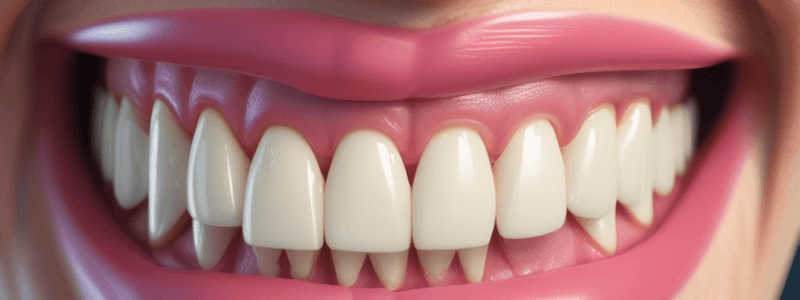Podcast
Questions and Answers
What are edentulous areas referred to as under the Applegate classification system?
What are edentulous areas referred to as under the Applegate classification system?
- Saddles
- Spaces
- Modifications (correct)
- Classifications
How are edentulous areas other than classification determinants designated?
How are edentulous areas other than classification determinants designated?
- By their material
- By their number (correct)
- By their location
- By their size
Under the Applegate classification system, what does Class III describe?
Under the Applegate classification system, what does Class III describe?
- Anterior edentulous areas
- A single bounded saddle (correct)
- Multiple bounded saddles
- Completely edentulous arches
According to Applegate Rule 7, what is considered when determining the modification?
According to Applegate Rule 7, what is considered when determining the modification?
Why can no modification areas be included in Class IV arches?
Why can no modification areas be included in Class IV arches?
In the Applegate system, what distinguishes Class I from Class II?
In the Applegate system, what distinguishes Class I from Class II?
In a Kennedy Class III Modification 1, how many bounded saddles are there?
In a Kennedy Class III Modification 1, how many bounded saddles are there?
What determines whether a denture falls into Class IV according to the Applegate rules?
What determines whether a denture falls into Class IV according to the Applegate rules?
What is considered when determining the modification according to Applegate Rule 7?
What is considered when determining the modification according to Applegate Rule 7?
Flashcards
Applegate Rule 6
Applegate Rule 6
Edentulous areas outside of the classification are considered modifications, notated by a number.
Applegate Rule 7
Applegate Rule 7
The extent of modification areas is irrelevant; only the quantity of extra edentulous areas matters for classification.
Applegate Rule 8
Applegate Rule 8
Modification areas can't be included in Class IV arch classifications.
RPD Types
RPD Types
Signup and view all the flashcards
RPD Objectives
RPD Objectives
Signup and view all the flashcards
Caries
Caries
Signup and view all the flashcards
Periodontal Disease
Periodontal Disease
Signup and view all the flashcards
Kennedy Class I
Kennedy Class I
Signup and view all the flashcards
Kennedy Class II
Kennedy Class II
Signup and view all the flashcards
Kennedy Class III
Kennedy Class III
Signup and view all the flashcards
Kennedy Class IV
Kennedy Class IV
Signup and view all the flashcards
Applegate Rule 1
Applegate Rule 1
Signup and view all the flashcards
Applegate Rule 2
Applegate Rule 2
Signup and view all the flashcards
Applegate Rule 3
Applegate Rule 3
Signup and view all the flashcards
Applegate Rule 4
Applegate Rule 4
Signup and view all the flashcards
Applegate Rule 5
Applegate Rule 5
Signup and view all the flashcards
Distal Extension Situations
Distal Extension Situations
Signup and view all the flashcards
Long Span
Long Span
Signup and view all the flashcards
Kennedy Classification
Kennedy Classification
Signup and view all the flashcards
Study Notes
Applegate Rules for Kennedy Classification
- Applegate Rule 6: Edentulous areas other than those determining the classification are referred to as MODIFICATION (S) and are designated by their number.
- Applegate Rule 7: The extent of the modification is not considered, only the number of additional edentulous areas are considered.
- Applegate Rule 8: No modification areas can be included in Class IV arches.
Removable Partial Dentures (RPD)
- Types of RPD: Acrylic partial dentures (Flipper), Cast partial dentures (Cr-Co), and Flexible partial dentures (Valplast)
- Objectives of RPD Construction:
- Restore esthetic
- Restore function (phonetic and mastication)
- Prevent apposing teeth extrusion or migration and tilting of adjacent teeth
- Fill empty space or spaces
- Prevent disease atrophy
- Restore the psychological status of the patient
- Achieve proper muscular balance
Causes of Teeth Loss
- Main causes of teeth loss:
- Caries (main cause in young people below 35 years)
- Periodontal diseases (main cause in old people above 35 years)
- Trauma or accident
- Congenital missing teeth
Indications of Removable Partial Dentures (RPD)
- Distal extension situations (free end situation)
- Long span tooth-bounded edentulous area
- Need for cross-arch (bilateral) stabilization
- Excessive loss of the residual ridge
- Unusually sound abutment teeth
Kennedy Classification
- The Kennedy method of classification was originally proposed by Dr. Edward Kennedy in 1925
- It attempts to classify the partially edentulous arch in a manner that suggests certain principles of design for a given situation
- Kennedy divided all partially edentulous arches into four basic classes
Classification of Partially Edentulous Arches
- Class I: Bilateral edentulous areas located posterior to the natural teeth
- Class II: A unilateral edentulous area located posterior to the remaining natural teeth
- Class III: A unilateral edentulous area with natural teeth remaining both anterior and posterior to it
- Class IV: (not defined in the text, but implied as a separate class)
Applegate Rules
- Applegate Rule 1: Classification should follow rather than precede any extractions of teeth that might alter the classification
- Applegate Rule 2: If a third molar is missing and not to be replaced, it is not considered in the classification
- Applegate Rule 3: If a third molar is present and is to be used as an abutment, it is considered in the classification
- Applegate Rule 4: If a second molar is missing and is not to be replaced, it is not considered in the classification
- Applegate Rule 5: The most posterior edentulous area (or areas) always determines the classification
Studying That Suits You
Use AI to generate personalized quizzes and flashcards to suit your learning preferences.




